
table of contents
- 1. Chokeberry (Aronia)
- 2. Barberry species (Berberis)
- 3. Rock pear (Amelanchier)
- 4. Firethorn (Pyracantha)
- 5. Dogwood species (Cornus)
- 6. Hazelnut (Corylus avellana)
- 7. Hydrangeas
- 8. Honeysuckle (Lonicera)
- 9. Jasmine (Jasminum and Philadelphus)
- 10. Currant (Ribes)
- 11. Cherry laurel (Prunus laurocerasus)
- 12. Privet (ligustrum)
- 13. Sloe (Prunus spinosa)
- 14. Snowball species (Viburnum)
insects are now more dependent than ever on the fact that they are actively supported by gardeners with small gardens. It is not enough to simply hang up an insect hotel. It is particularly important to provide the animals with enough food, as they are less and less able to find it in their natural environment. Flowering shrubs with different flowering times can expand the food supply for bees and co. From spring to autumn. The following selection provides a brief overview.
1. Chokeberry (Aronia)
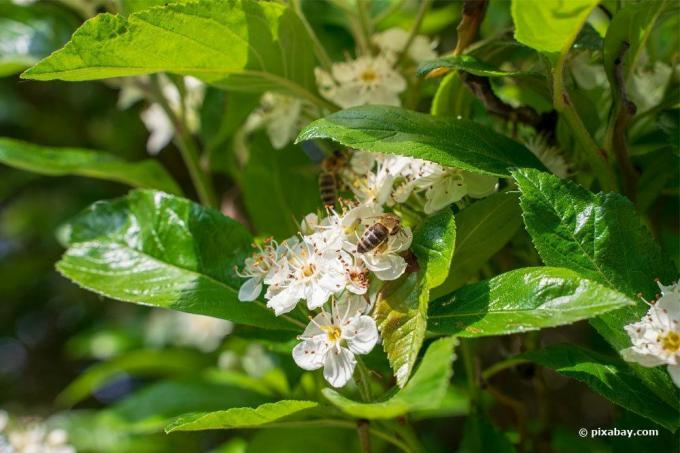
The aronia can be refined on slow-growing trunks and then grows as a small tree, but it can also be cultivated as a shrub. While the flowers are visited and pollinated by insects, the berries, if not harvested, are eaten by birds in late autumn.
Size: as a shrub one to two meters high
Location: likes sun and partial shade, otherwise no special demands
Blossom: May, in dense clusters, colored white
Care:
- undemanding, tolerates drought
- No fertilization necessary, mulch if necessary
- thin out every now and then in autumn or winter
- Propagation via runners possible, can also be removed
- little susceptible to Pests and diseases
Tip: The berries are considered a healthy superfood.
2. Barberry species (Berberis)

Only the common one is at home in Germany Barberry, also called sea buckthorn. There are cultivars for the garden that come mainly from East Asia. The common barberry is a host of grain rust and has therefore almost been exterminated. After flowering, red berries form, which are eaten by birds.
Size: medium-high shrubs
Location: prefers sun, copes with shade, hardly any soil requirements
Blossom: May to June, yellow
Care:
- Mulch replaces additional watering and fertilizing
- No fertilization necessary, mulch if necessary
- Cut not necessary, but tolerated
- Wear gloves because of sharp thorns
- Propagation via cuttings
- Black vine weevil can attack evergreen varieties
- Powdery mildew possible with deciduous varieties
Sorts:
- Evergreen barberries (Berberis julianae and frikardii)
- Thunberg barberry (Berberis thunbergii)
- Snow barberry (Berberis candidula)
3. Rock pear (Amelanchier)
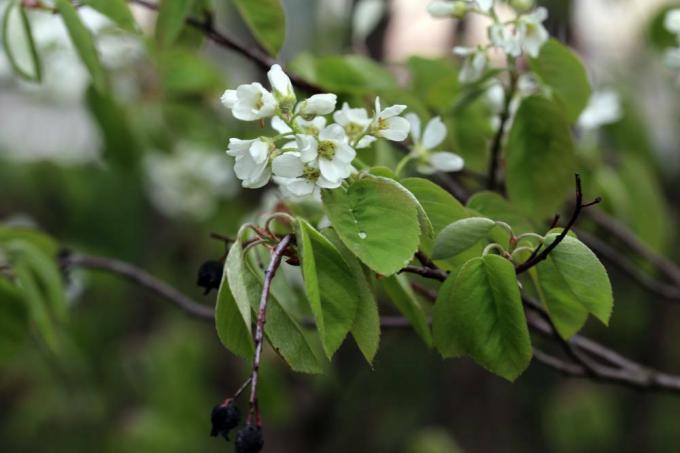
The native common rock pear occurs mainly on dry sites. Other varieties, such as the copper rock pear, can also be planted in the garden. However, some species grow very large.
Size: native species around two meters, larger ones up to six meters
Location: sunny to partially shaded, well-drained soil, improve with sand if necessary
Blossom: April, racemose inflorescences, white
Care:
- pour not necessary
- Fertilize in the spring with compost
- Cut not necessary
- is considered robust, powdery mildew can occur
4. Firethorn (Pyracantha)
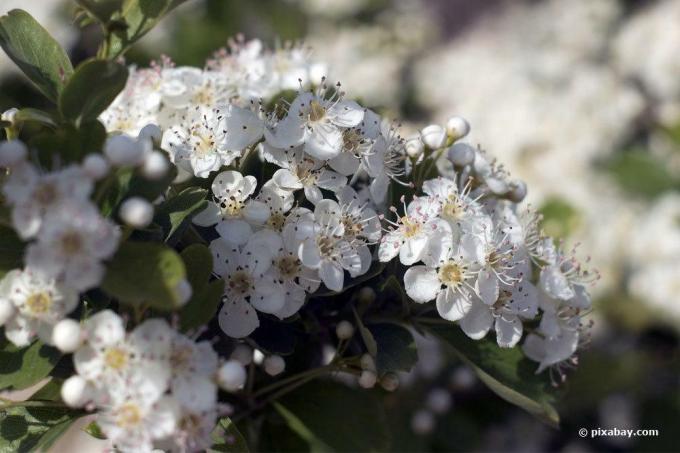
Cultivars that have been crossed from the different wild varieties are mainly used for the garden. The berry color can therefore vary. The fruits are very sour and are also eaten late by birds when there is nothing else left. Abundant flowering is only achieved if the shrub is free to grow.
Size: 1.5 to four meters
Location: full sun, very tolerant of heat, also gets along well in cities, no demands on the soil
Blossom: May to June, panicle-like, white color
Care:
- watering is not necessary even in dry conditions
- fertilize with compost in spring
- Tolerates pruning, but pruning ensures fewer flowers
- wear gloves when working
- can be propagated using cuttings
- is considered robust, infestation with black weevils possible
5. Dogwood species (Cornus)
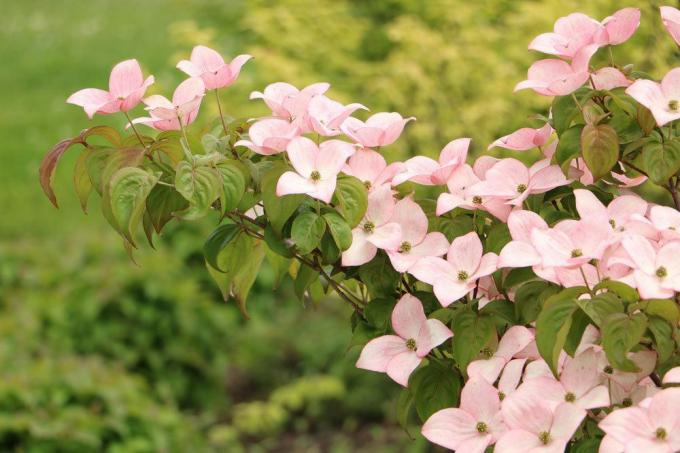
These include the Cornelian cherry, which is considered to be very friendly to bees, but mostly grows as a tree. It blooms far before other fruit trees in February to April, the fruits are edible. Dogwood varieties that grow as shrubs often have brightly colored bark and leaves, which turn attractively in autumn.
Synonym: Horn shrub
Size: medium-sized as a shrub
Location: nutrient-rich soils with lime content, sunny
Blossom: mostly white in color, but also yellow, May to June, except cornel cherry
Care:
- Watering and fertilizing are not absolutely necessary
- Mulching keeps soil moist and fertile
- No cut should be made
- Propagation via cuttings or offshoots
- hardly susceptible to pests and diseases, watch out for fungal infestation and lice
Sorts:
- Red dogwood (Cornus sanguinea)
- Tatar dogwood (Cornus alba)
- Bunk dogwood (Cornus controversa)
6. Hazelnut (Corylus avellana)
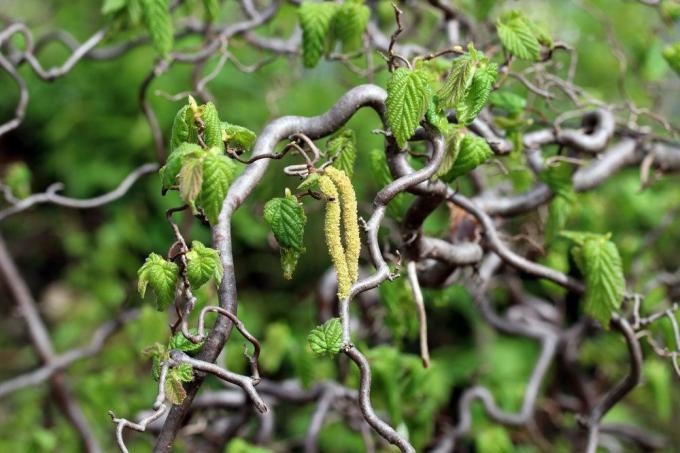
Hazelnuts not only offer a rich harvest for the gardener. The flowers of the bushes, which open very early in the year, are often the first food for bees and insects. In addition, a hazelnut bush provides shelter for birds and small mammals and, if the nuts are not harvested, provides food for birds and mice.
Synonyms: Common hazel, hazel bush
Size: up to seven meters
Location: lots of sun, otherwise only small nuts are formed, deep, nutrient-rich soil
Blossom: Flower color inconspicuous, pollination therefore takes place by wind, February and March
Care:
- Pour only when it is dry
- Fertilize in early spring, too much will encourage wood growth
- Regular pruning for a loose crown and rich harvest
- Propagation by subsidence
- hardly susceptible to disease
- the most common pest is the hazelnut borer
Note: Hazelnuts are more productive if several shrubs are planted.
7. Hydrangeas

They're not just popular Garden plants. The bushes bloom very profusely and provide food for bees and insects for a long time. Some varieties also have a very attractive autumn color.
Size: up to two meters
Location: partially shady, humus-rich and moist soil, rather acidic
Blossom: Different colors, partly depending on the nature of the soil, July to September
Care:
- needs a lot of water, watering regularly
- Heavy eaters, fertilize with manure, not later than July
- Thinning possible, excessive pruning endangers flowering
- can freeze back heavily in cold winters, cut off what is frozen
- Propagation via cuttings
- watch out for fungal diseases, protect young plants from snails
Sorts:
- Oak-leaf hydrangea (Hydrangea quercifolia)
- Ball hydrangea (Hydrangea arborescens)
- Velvet hydrangea (Hydrangea aspera)
- Farmer's hydrangea (Hydrangea macrophylla)
- Panicle hydrangea (Hydrangea paniculata)
- Plate hydrangea (Hydrangea serrata)
Note: Climbing varieties are also friendly to bees.
8. Honeysuckle (Lonicera)

To the Honeysuckles not only include the species that grow as a shrub, but also those that wind up as lianas on other plants. The flowers often have a strong odor and are dependent on pollination by moths, bumblebees or hover flies.
Synonyms: Honeysuckles, also known as liana: Jelängerjelieber
Size: 50 to 70 cm, lianas several meters
Location: different, mostly sunny, but also shady, soil permeable and moist
Blossom: between May and June, white, yellow and red
Care:
- Drought is tolerated, deep roots, provide themselves with moisture
- Fertilizing is not absolutely necessary
- regular pruning encourages new flowers
- Propagation can be done using cuttings
- robust against diseases
- susceptible to aphids
Note: The winter scented honeysuckle (Lonicera purpusii) is a specialty, it blooms from January.
9. Jasmine (Jasminum and Philadelphus)

Both genera are not related to each other, but both have a strong smell and are very bee-friendly. The flowers also attract other insects. The false jasmine (Philadelphus) will also be Pipe bush called.
Size: one to four meters
Location: Sun to partial shade, the lighter the more flowers, hardly any soil requirements
Blossom: Winter jasmine blooms yellow from December, other species white from May
Care:
- water regularly
- Provide nutrients from time to time during the growth phase
- occasional thinning promotes flowering
- Propagation via cuttings
- is considered robust
Species:
- Winter jasmine (Jasminum nudiflorum)
- Farmer's Jasmine (Philadelphus coronarius)
- Garden jasmine (Philadelphus x lemoinei)
10. Currant (Ribes)

Planting berry bushes in the garden offers two advantages. Insects receive food during flowering and the berries can be harvested later. The shrubs are pollinated not only by bees and Co., but also by wind. Apply to all types of berries in the garden Currants as particularly bee-friendly.
Size: depending on the variety up to 1.5 meters
Location: Full sun for particularly aromatic berries, nutrient-rich soil
Blossom: inconspicuous and early, endangered by late frost
Care:
- Water regularly and thoroughly, shallow roots dry out easily, mulch
- Provide compost two to three times a year
- Care cut in winter
- Propagation via cuttings or subsidence
- susceptible to powdery mildew, watch out for black currant aphid infestation
11. Cherry laurel (Prunus laurocerasus)

This dense hedge plant is not only popular with insects for its flowers. The berries serve as food for birds and the dense foliage offers enough hiding places. Sometimes birds also breed in Cherry laurel-Hedges.
Synonym: Laurel cherry, Pontic laurel cherry
Size: uncut shrubs four to seven meters
Location: semi-shady to shady, prefers loamy soil
Blossom: May to June, creamy white, candle-like inflorescences
Care:
- as a hedge plant, water and fertilize regularly, otherwise undemanding
- Cut in June, depending on the desired shape
- Propagation mainly via cuttings
- watch out for fungal infestation, also susceptible to black weevils
12. Privet (ligustrum)
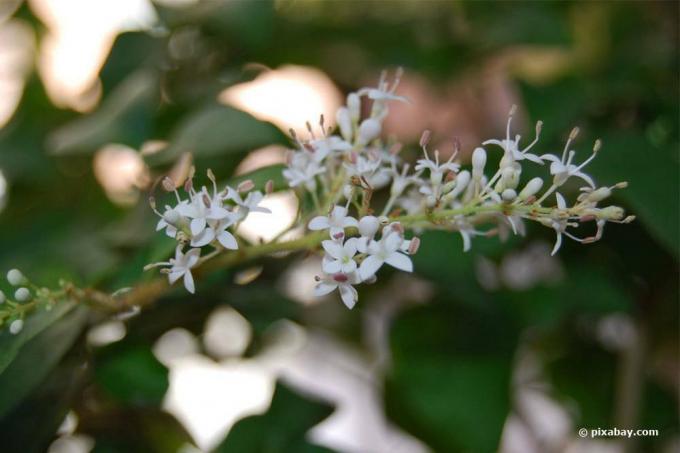
Also the liguster is one of the popular Hedge plants. Many varieties are wintergreen, which means that they lose their leaves very late and can therefore offer protection for birds even in winter. The berries, which are poisonous for humans, are eaten by birds, whereas bees and other insects like to visit the flowers of the bushes.
Synonym: Rain pastures
Size: one to four meters, uncut bushes also larger
Location: undemanding, prefers sun and drought
Blossom: yellowish white, June
Care:
- very drought tolerant
- Provide compost in the spring
- possibly regular topiary
- is propagated via cuttings
- can be attacked by aphids or powdery mildew, otherwise robust
13. Sloe (Prunus spinosa)

The sloe grows wild in natural hedges or can be grown in the garden. The fruits are edible, but only edible after the first frost. It should be noted that the blackthorn easily reproduces itself and can quickly form dense undergrowth through root runners.
Synonym: Sloe thorn, sour plum, hedge thorn, black thorn, German acacia
Size: three to five meters
Location: sunny and warm, overgrown even on poor soils
Blossom: white, March to April, very numerous
Care:
- does not have to be fertilized or watered
- possibly taper cut
- multiplies via root runners, remove excess
- serves as a host plant for some butterfly species, otherwise watch out for aphids and fungal diseases
14. Snowball species (Viburnum)
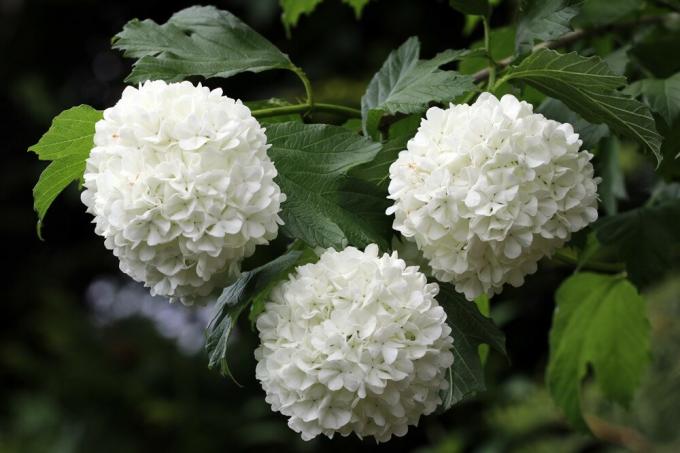
The snowball gets its name because of the mostly round inflorescences. These are often visited by bees and co., Who also ensure that the bushes are pollinated. The berries that form later are red and only edible when fully ripe. The plant itself is considered to be slightly poisonous.
Size: 0.5 to four meters
Location: Sun, partial shade is tolerated, soil not too dry
Blossom: white, inflorescence spherical, April to June, winter snowball from November
Care:
- requires little maintenance
- Mulching keeps soil moist and nutritious
- Cutting is tolerated but not necessary
- Propagation via cuttings
- is attacked by the snowball leaf beetle, watch out for powdery mildew
Species:
- Winter snowball (Viburnum fragrans)
- Easter snowball, Korean snowball (Viburnum carlesii)
- Evergreen viburnum (Viburnum burkwoodii)
- Common snowball (Viburnum opulus)
